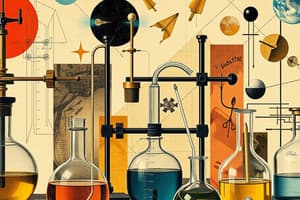Podcast
Questions and Answers
What is the primary use of a burette in a laboratory setting?
What is the primary use of a burette in a laboratory setting?
- To cool down vapors into liquids
- To separate a mixture of two liquids with different boiling points
- To measure specific volumes of solid chemicals
- To deliver solution in precisely-measured variable volumes (correct)
Which instrument is specifically designed to secure clamps to a support stand?
Which instrument is specifically designed to secure clamps to a support stand?
- Iron Clamp Assembly (correct)
- Separatory Funnel
- Cork Borer
- Hot Water Bath
What is the function of a separatory funnel?
What is the function of a separatory funnel?
- To separate a mixture’s components into two solvent phases (correct)
- To condense vapors back into liquid form
- To accurately prepare a solution with a known concentration
- To melt or burn solid chemicals
Which of the following best describes the design of a Florence flask?
Which of the following best describes the design of a Florence flask?
What is the purpose of a hot water bath in laboratory procedures?
What is the purpose of a hot water bath in laboratory procedures?
What is the primary use of a Graduated Cylinder in the laboratory?
What is the primary use of a Graduated Cylinder in the laboratory?
Which apparatus is most suitable for supporting a crucible during heating?
Which apparatus is most suitable for supporting a crucible during heating?
What is the function of a Medicine Dropper in laboratory procedures?
What is the function of a Medicine Dropper in laboratory procedures?
Which laboratory apparatus is ideal for mixing and containing liquids?
Which laboratory apparatus is ideal for mixing and containing liquids?
What is the primary use of a Wire Gauze in laboratory practices?
What is the primary use of a Wire Gauze in laboratory practices?
When heating a liquid solution to separate its components, which apparatus would be the most effective?
When heating a liquid solution to separate its components, which apparatus would be the most effective?
For what purpose is a Mortar & Pestle commonly used in laboratory settings?
For what purpose is a Mortar & Pestle commonly used in laboratory settings?
Which laboratory apparatus is specifically designed for rinsing and cleaning narrow glassware?
Which laboratory apparatus is specifically designed for rinsing and cleaning narrow glassware?
Flashcards are hidden until you start studying
Study Notes
Common Laboratory Apparatuses
- Test Tube: Holds, mixes, or heats small quantities of solids or liquids.
- Erlenmeyer Flask: Ideal for mixing, heating, and storing liquids; versatile in liquid-handling processes.
- Graduated Cylinder: Calibrated to accurately measure specific volumes at certain temperatures.
- Beaker: Functions as a reaction container; suitable for holding liquids or solid samples.
- Ordinary Funnel: Separates solid substances from solutions; aids in transferring materials into narrow containers.
- Watch Glass: Circular glass piece for evaporating liquids and weighing solids.
- Wire Gauze: Metal sheet used to evenly distribute heat and prevent direct heating.
- Iron Stand: Supports apparatus like burettes and flasks for stability during experiments.
- Iron Clamp: Holds glassware securely while mounted on an iron stand.
- Iron Ring: Supports glassware, functioning as a stabilizer during experiments.
- Mortar & Pestle: Tools for crushing solids into smaller pieces or grinding into fine powder.
- Evaporating Dish: Allows for the separation of liquids from solids by evaporation.
- Stirring Rod: Mixes liquids or solids, can assist in transferring liquids between glassware.
- Thermometer: Measures temperature by utilizing materials that expand or contract with heat.
- Test Tube Rack: Holds multiple test tubes upright simultaneously for convenience.
- Medicine Dropper: Transfers small liquid quantities with precision.
- Crucible Tong: Safely lifts hot crucibles from heat sources.
- Test Tube Holder: Holds hot test tubes securely to prevent burns.
- Clay Triangle: Supports crucibles over a Bunsen burner for heating.
- Water-trough: Contains water for gas collection.
- Test Tube Brush: Cleans test tubes and narrow glassware effectively.
- Pipet: Measures or transfers small liquid volumes, often in milliliters or microliters.
- Volumetric Flask: Accurately measures a specific volume for precise solution preparation.
- Cork Borer: Cuts holes in cork or rubber stoppers for glass tubing insertion.
- Florence Flask: Also known as ‘boiling flask’; used for heating or boiling solutions, features a round body and long neck.
- Separatory Funnel: Used in liquid-liquid extraction to separate components with differing densities.
- Burette: Delivers solutions in precise volumes, crucial for titration processes to reach accurate reaction endpoints.
- Fish Tail/Wing Top: Attaches to a Bunsen burner to spread heat over a wider area.
- Crucible and Cover: Designed for high-temperature melting or burning of solid chemicals.
- Distilling Flask: Separates liquids with different boiling points through distillation.
- Condenser: Cools vapors to convert them back into liquid form.
- Hot Water Bath: Provides gentle heating for flammable chemicals to prevent fire hazards.
- Capillary Tube: Thin tubes enabling liquids to move against gravity via capillary action.
- Adapter: Connects different lab glassware pieces with incompatible joint sizes.
- Iron Clamp Assembly: Secures utility clamps to a support stand for stability in experiments.
Studying That Suits You
Use AI to generate personalized quizzes and flashcards to suit your learning preferences.




